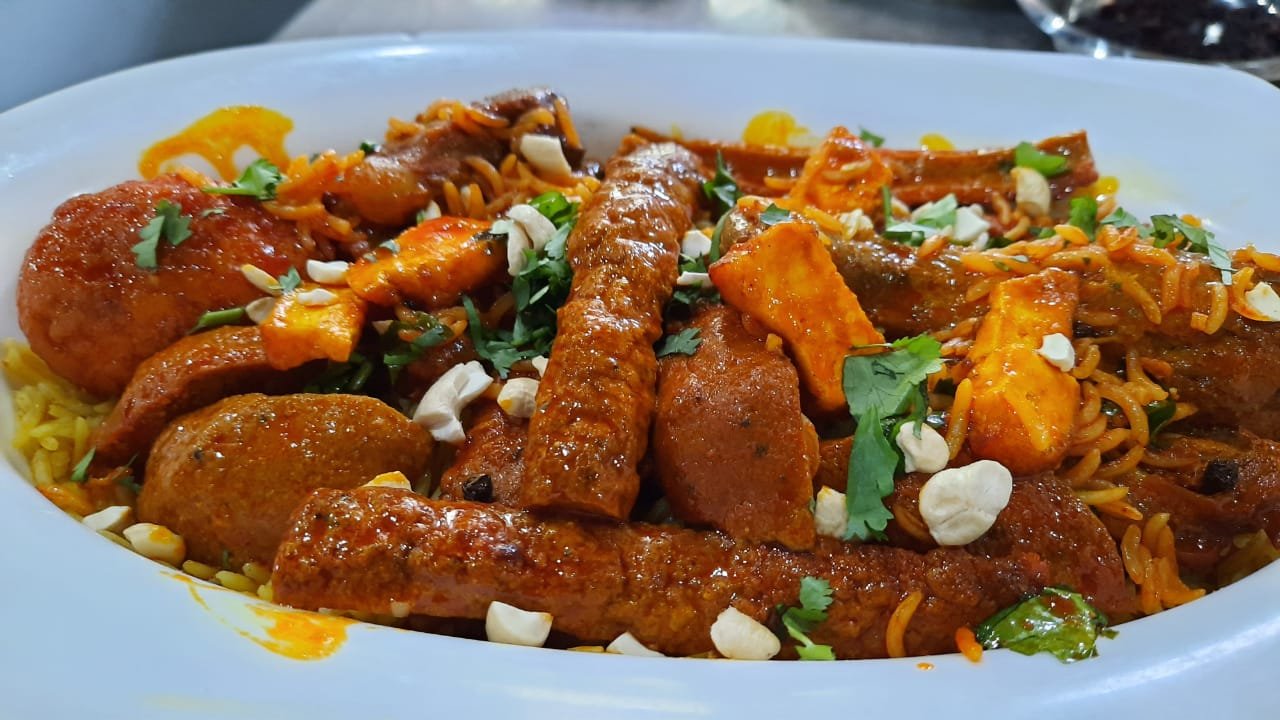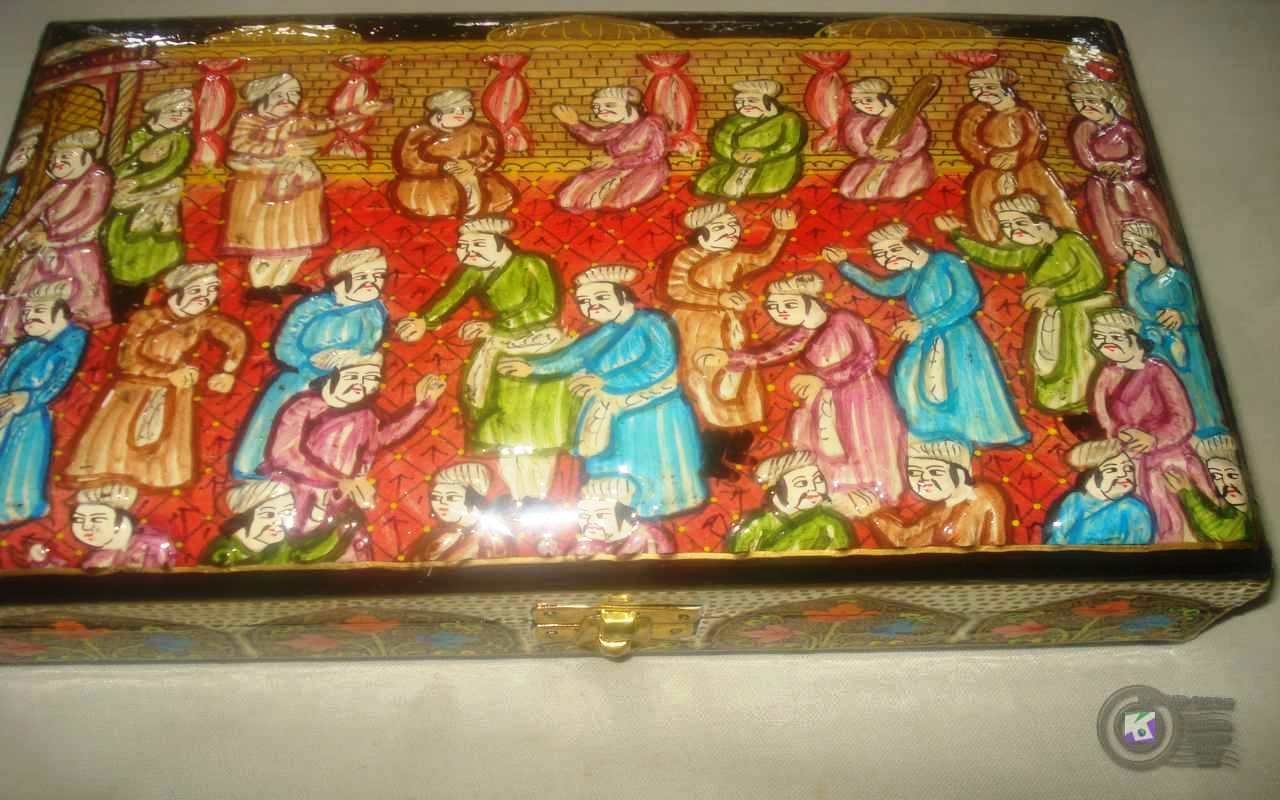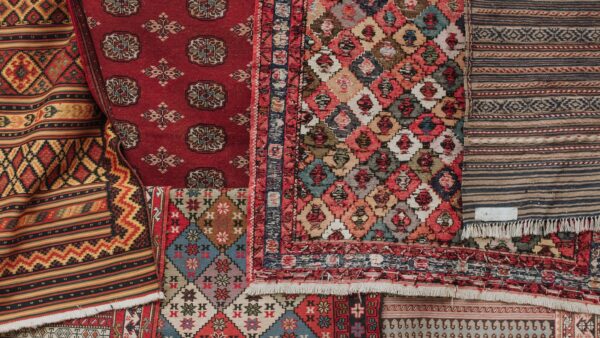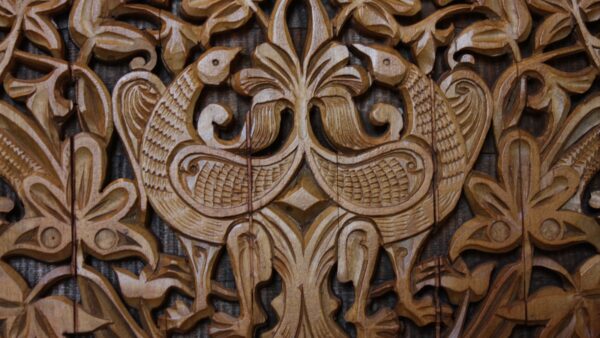Kabab (minced meat roasted on skewers over hot coals)

Kabab, a traditional meat product of wazwan, is made up of minced meat, eggs, along with spice blends that are added while mincing, and then wrapped around an iron rod (20–30 cm long) for cooking. Traditionally, kababs are cooked by charbroiling, but nowadays they are also prepared by grilling, roasting, or stewing. While cooking, the internal temperature should be 75 ± 2°C, which can be achieved by charbroiling at 230 ± 2°C for 3 minutes or oven roasting at 180 ± 2°C for 12 minutes. More people prefer charbroiled kababs than those cooked by other methods because of they have better appearance (browning), flavor (smoked), juiciness, and texture.
Daeni Phoul

It is a large mutton piece, cooked without gravy.
Waze kokur or waza chicken

Two halves or two whole chicken are cooked and garnished with chopped coriander and melon seeds.
Meth Maaz

Underneath all these dishes, lies Methi. It is a sort of stew usually made with lamb stomach and flavored with methi or fenugreek leaves. Don’t be a baby. It’s really good. There are 4 small divisions of methi.
Daniwal Korma (a mutton curry with lots of coriander)

The word ‘dhaniwal’ refers to coriander in the local Kashmiri language. Dhaniwal Korma is mutton korma cooked in a lot of coriander or dhaniya and yogurt based gravy
Rista (meatballs in a fiery red gravy)

Rista is a restructured meat product of Kashmiri wazwan prepared from meat emulsion with added fat (20%), salt, cumin, and cardamom seeds. The emulsion is prepared from mutton or beef depending on local, ethnic, or regional taste. The emulsion is manually pounded along with fat using a specially designed wooden hammer called goshpare (gosh means meat and pare means hammer) over a stone platform called maz-kaane (maz means meat and kaene means stone), and spices, salt, and a small quantity of chilled water are added while it is being minced. The meat emulsion is then pressed by hands and rolled between palms into compact balls. The meatballs are then processed in gravy to get rista as the finished product. The gravy is made from water, red chilli extract, hydrogenated vegetable oil, and a ground spice mixture and condiments
Rogan Josh (tender lamb cooked with Kashmiri spices)

Rogan josh is a red hot lamb or mutton meat product, and the word is a combination of rogan, which means “oil or fat,” and josh, which means “intense heat.” Thus, rogan josh means made in oil at intense heat. Rogan josh is a red hot lamb or mutton meat product, and the word is a combination of rogan (which means red color) and josh (which means either passion or heat). Kashmiri red chillies impart the color and make it mildly hot, but the red color of the dish is attributed to the extract from dried cockscomb flowers, locally known as mawual. The lamb or mutton meat is marinated for 2 hours and is cooked in oil with added spices until it becomes brown. After that, it is stirred in a cooking vessel to develop its characteristic flavor.
Tabak Maaz

Ribs of lamb simmered in yogurt till tender, then fried, can be served as a snack/side-dish
Tabak maaz is a popular product of wazwan made from the rib portion of sheep meat. The rib of lamb or mutton is cut into small pieces, moderately steam cooked, and applied with salt and turmeric.
The rib bones are then removed, and only the meat chunks are shallow fried in desi ghee over mild heat for a longer period. The finished product becomes crispy in nature and served as dry pieces.
Marchhwangan korma or Mirchi ka korma


Marchwangan means red chilly inKashmiri.
This dish as spicy as it sounds.
Mutton korma is cooked with fiery hot Kashmiri chillies and spices.
Aab Gosht (spicy lamb curry)
Aab gosh is a sacral area of the vertebral column prepared in milk. For the preparation of aab gosh, lamb or mutton is boiled in water with salt, ginger, garlic paste, and aniseed powder. The milk is then boiled along with spices such as green cardamom, onions, pepper, and ghee, to which the lamb or mutton is added. The meat along with milk curry is then stirred thoroughly until it boils well.
Aab gosh, a traditional meat product of wazwan, is a sacral area of the vertebral column of lamb/mutton prepared in milk. It is a mild dish of wazwan with tender and juicy meat cooked in milk without any hot spices. The spices and condiments used for its preparation include ginger, garlic paste, aniseed powder, green cardamom, and onions.
Marchwangan Korma (an extremely hot lamb preparation)
Gushtaba (a velvety textured meatball in white yogurt gravy, a specialty)

Goshtaba is a popular meat product of wazwan and is defined as restructured meat product prepared from meat emulsion with added fat (20%), salt (2.5%), cumin (0.1%), and cardamom seeds (0.2%) cooked in the curd. Like rista, it is prepared from pounded meat emulsion. The only difference is that goshtaba is cooked in gravy called yakhni made from curd, water, spices, and condiments. Rista and goshtaba differ in flavor profile owing to the basic differences in the formulation of gravy. Nowadays, machine mincing is used for the preparation of these products, but the quality of traditionally processed goshtaba and rista is reported to be superior to that of machine-minced products. To prepare yakhni, two parts of fresh curd is homogenized with one part of water with a stirrer, then transferred to a thick-bottomed copper utensil and heated rapidly for 10–15 minutes. During heating, curd is constantly stirred until it reaches the boiling point. Hydrogenated mustard oil is added to the mix, and boiling is continued for 10–15 minutes. Then garlic paste is added followed by a spice mixture. Fried onion paste is added at the end. Boiling is continued until the added oil floats back. At this stage, the remaining water is added, and yakhni is cooked further for 10–15 minutes to obtain a desirable consistency. Salt is added toward the end of cooking. The meatballs are then transferred to the boiling yakhni and cooked for 30 minutes to get the goshtaba in its final form. In the series of different meat products served in wazwan, goshtaba is the last one to be served. Because of the popularity of rista and goshtaba, their market potential can be exploited by small-scale industries by packing them in retort cans for long-term storage at ambient temperature or in low-density polyethylene pouches for increased shelf life up to 7 days in refrigerated storage.







Leave a comment